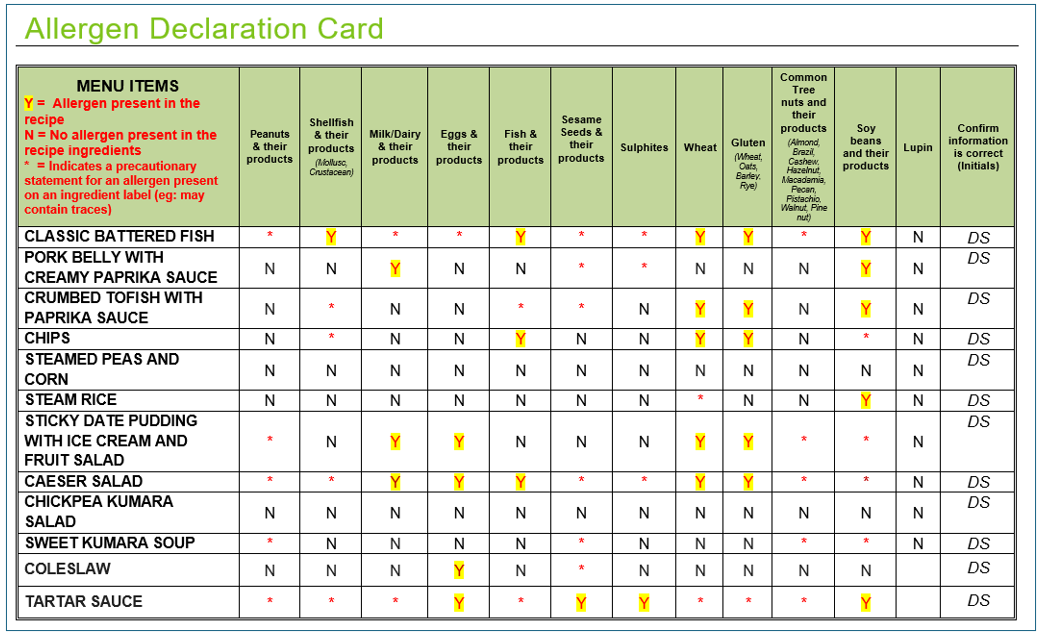Understanding Allergen Declaration Card
To maintain our commitment in providing foods that meet high safety and suitability standards, allergen declaration cards are one of the allergen management processes we have to ensure accurate information is provided for you to make safe and informed meal choices.
What are Allergen Declaration Cards?
In accordance with Ministry for Primary Industries (MPI) guidelines, foods containing the common 21 food allergens* are declared so that consumers (i.e., you!) have a clear understanding of what is in your meals. Every dining hall will have allergen declaration cards displayed corresponding to the menus of the day.
The allergen declaration cards will list menu items available at each meal service and are displayed across serveries and buffet stations.
*The 21 common food allergens are: Peanuts, Shellfish (mollusc and crustacea), Milk, Eggs, Fish, Sesame seeds, Sulphites, Wheat, Gluten, Tree nuts (Almond, Brazil, Cashew, Hazelnut, Macadamia, Pecan, Pistachio, Walnut, Pine nuts), Soy and Lupin.
Why is this important for me?
People with food allergies or intolerance need to know what is in their foods, so that they can decide if it is safe for them to eat.
The allergen declaration cards are there to provide such information so that students can identify what allergens are present at each meal and confidently decide on what meals are safe for them and what meals to avoid.
What if I have food allergies that are not listed on the Allergen Declaration Card?
Communication is key! Before meal selection, please do not hesitate to speak to your supervisor or head chef about your dietary requirements. They will be able to advise meals that are suitable for you or offer you alternatives as appropriate.
Additionally, if you would like to speak to someone regarding your dietary requirement(s) and discuss how we can better support your dining experience and nutrition whilst at the dining hall, please reach out and ask for your head chef. Alternatively, you can also reach us through our Ask a Dietitian or contact form.
How do I read an Allergen Declaration Card?
There are three key abbreviations or symbols to know:
Y means ‘this allergen is present in the menu item’
N means ‘this allergen is NOT present in the menu item’
* means ‘this menu item may contain traces of this allergen as per the manufacturer labels’
If we took this Allergen Declaration Card as an example and looked at menu ‘PORK BELLY WITH CREAMY PAPRIKA SAUCE’. This menu:
Contains the following allergens (Y):
Milk/Dairy, and Soy
Does NOT contain the following allergens (N):
Peanuts, Shellfish, Eggs, Fish, Wheat, Gluten, Tree nuts, Lupin
May contain traces of the following allergens (*):
Sesame seeds, Sulphites
You may find that for deep-fried menu items, certain items may have a few additional allergens declared that may not be commonly present. It is important to note that deep-fried menu items are cooked in the same oil with allergen-containing and non-plant-based foods. As such, traces of certain allergens will be present across these menu items from its preparation method.
As an example, if we took the same allergen declaration card as an example and looked at ‘CHIPS’. This menu:
Contains the following allergens (Y):
Fish, Wheat, and Gluten
Does NOT contain the following allergens (N):
Peanuts, Milk/Dairy, Eggs, Sesame Seeds, Sulphites, Tree nuts, and Lupin
May contain traces of the following allergens (*):
Shellfish, Soy
What else should I know about the Allergen Declaration Cards?
Each menu’s allergen declaration is taken from the product’s back of pack labelling or product specification sheets.
However, it is important to note that:
All meals are prepared in a kitchen that also handles Wheat, Gluten, Dairy/Milk, Egg, Soy, Fish, Shellfish, Tree Nuts, Peanuts, Sesame, Sulphites and Lupin.
Deep fried menu items are cooked in the same oil with allergen-containing and non-plant-based foods.
Self service stations are a risk of cross-contamination.
QUICK RECAP -
Before meal selection -
Look out for allergen declaration cards displayed across the serveries.
Within the card, look out for the ‘Y’, ‘N’ and ‘*’ indicators of what allergens are present in the meal(s). This will help you decide what meals are safe for you and your dietary requirements.
If you are unsure of what to have, or have any questions about the meals, reach out to your head chef!
Should you wish to speak to someone regarding your dietary requirement(s) and discuss how we can better support your dining experience and nutrition whilst at the dining hall, you can reach out to us through your residence hall manager! Alternatively, you can also reach us through our Ask a Dietitian or contact form.

